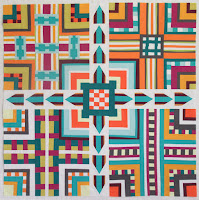Maria Shell's Improv Patchwork book arrived and I've spent hours looking through it.
 |
| incorrect |
 |
| correct |

 |
| incorrect |
 |
| correct |

Mary at ZippyQuilts invited me to be a guest on her blog! Even though I’ve been blogging for 11 years, this is the first time I’ve been invited to write a post for someone else's site. What I've written here also appears on her blog.
This post is to review a new book published by C&T: The Ultimate Guide to Rulerwork Quilting by Amanda Murphy.
Mary invited me to review the book knowing I'm an avid domestic machine quilter who began quilting in 2000, and started quilting with rulers in 2011.
Here's one of my first rulerwork attempts - doing a no-no by using a regular free motion quilting foot against a Fine Line brand quilting ruler.
 |
| Ruler work quilting with the WRONG machine foot! |
Two overall observations about the book:
 |
| from the book |
For me, currently using a Bernina 770QE for quilting, (I do not own a longarm), I was able to apply much of the information to my own Bernina experiences. She references using a stitch regulator, but those of us who quilt on a domestic machine with a stitch regulator, are unable to use the stitch regulator and a ruler work foot at the same time.
Interestingly, she mentions that rulerwork quilting is better for distributing quilting evenly across the surface because of being able to quilt in all directions.
 |
| from the book |
Amanda covers these important topics:
I concur with these points covered in the book:
Each sewing machine brand needs its appropriate high shank or low shank ruler work foot.
 |
| from the book |
Just as a quiltmaker invests in one or two most-used rotary cutting rulers, a rulerwork quilter need only invest in one or two rulers. Begin rulerwork quilting with a straight edge and/or gentle curve ruler and you’re good to go - like the Good Measure straight edge/curved edge ruler (above left), or Westalee straight edge/curved edge ruler (shown below).
These are some of the brands of rulers I've accumulated in the past nine years, with Fine Line rulers being the ones I use most often... probably because that's the brand I started with. I don't own any Good Measure brand rulers.
A bit about Fine Line rulers... They're different - made with two vertical posts to "hang onto" when quilting (see first blog picture). However, after buying a sewing machine with the dual feed feature, I quickly learned that these ruler posts bump into the dual feed! I can't use the ruler on the back of the ruler foot, so that's something to keep in mind when considering a Fine Line brand ruler.
 |
| Fine Line ruler posts bump into dual feed mechanism |
Amanda recommends the Sew Steady table, and that’s exactly what I have. Top it with a Supreme Slider (or a Queen Supreme if you have a large machine harp), and you’re good.
Here's my quilting set-up contrived by placing two hollow-core doors across four IKEA adjustable-height Finnvard trestles.
 |
| from the book |


 |
| Photo taken with my iPhone 8 - a very inaccurate representation of colors |
 |
| Aesa (4th grade) and Tay (5th grade) |